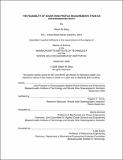The feasibility of sodar wind profile measurements from an oceanographic buoy
Author(s)
Berg, Allison M. (Allison May)
DownloadFull printable version (38.08Mb)
Other Contributors
Woods Hole Oceanographic Institution.
Advisor
Eugene A. Terray and Henrik Schmidt.
Terms of use
Metadata
Show full item recordAbstract
This thesis explores the feasibility of making wind speed profile measurements from an oceanographic buoy using a Doppler sodar. In the fall of 2005, we deployed a Scintec SFAS sodar on an ASIS buoy. Roughly one week of buoy motion data and one day of sodar observations were collected. Data from both this deployment, and the Martha's Vineyard Coastal Observatory, were used in conjunction with models to predict sodar performance. Results are compared for an ASIS and a 3-meter discus buoy. We also predict the yearly average probability of sodar data availability in the presence of buoy motion. We show that buoy tilting in response to wave forcing is the main factor affecting sodar performance. Our results strongly suggest that ASIS is a suitable platform for sodar measurements at sea.
Description
Thesis (S.M.)--Joint Program in Oceanography/Applied Ocean Science and Engineering (Massachusetts Institute of Technology, Dept. of Mechanical Engineering; and the Woods Hole Oceanographic Institution), 2006. This electronic version was submitted by the student author. The certified thesis is available in the Institute Archives and Special Collections. Includes bibliographical references (leaf 75).
Date issued
2006Department
Joint Program in Oceanography/Applied Ocean Science and Engineering; Woods Hole Oceanographic Institution; Massachusetts Institute of Technology. Department of Mechanical EngineeringPublisher
Massachusetts Institute of Technology
Keywords
/Woods Hole Oceanographic Institution. Joint Program in Oceanography/Applied Ocean Science and Engineering., Mechanical Engineering., Woods Hole Oceanographic Institution.